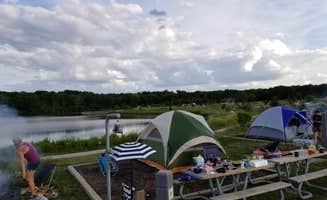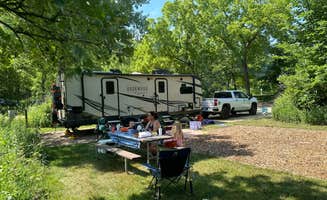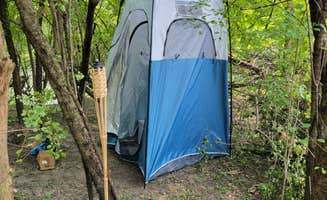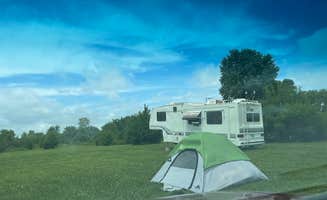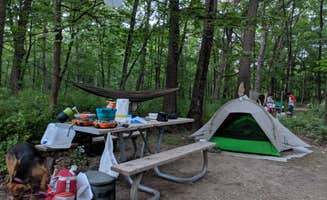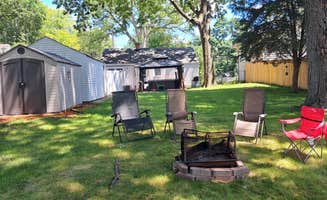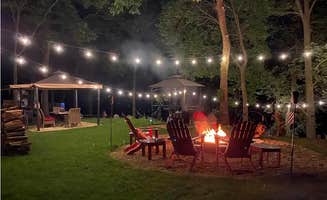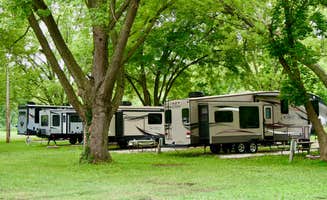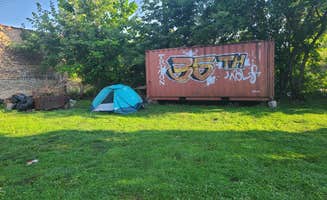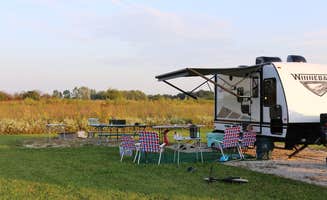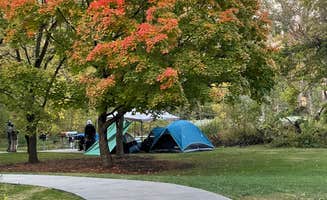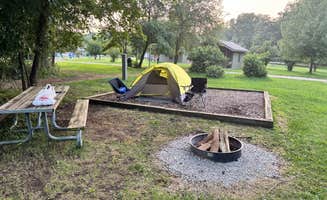Campsites near Woodridge, Illinois offer a mix of open-prairie and wooded settings with varying levels of shade coverage. Located 25 miles west of Chicago, the area features relatively flat terrain with elevations ranging from 650-750 feet above sea level. While larger state parks are found farther from town, several forest preserve campgrounds within a 30-mile radius provide both natural settings and convenient access to urban amenities.
What to do
Hiking trails and biking access: Camp Bullfrog Lake in Willow Springs connects to extensive trail systems perfect for mountain biking. "What's great about this location is the access to the miles and miles of MTB and hiking trails just out the front step of your campsite," notes Josh M. about Camp Bullfrog Lake. The trails accommodate various skill levels with multiple route options.
Fishing opportunities: Several campgrounds feature lakes and ponds for fishing. At Paul Wolff Campground in Elgin, visitors can fish in a small lake while observing local wildlife. "There are a few trails and I've seen lots of butterflies, gold finches, hawks, deer, flocks of giant sandhill cranes, rabbits, ground squirrels, and of course actual squirrels," reports Marisa A.
Water activities: Kayaking is available at certain locations, usually for an hourly fee. "The kayaks are $15 an hour and include life vests. The lake is pretty small but it was fun to putter around," mentions Layla P. about her experience at Camp Bullfrog Lake. Some campgrounds also offer boat rentals or launch access for personal watercraft.
What campers like
Proximity to Chicago: Many campers appreciate having natural spaces so close to urban areas. "Awesome place to stay when you live in the city and wanna get away," notes Deanna B. about Camp Bullfrog Lake. This convenience makes these campgrounds popular for weekend trips without extensive travel time.
Clean facilities: Well-maintained bathrooms and shower facilities are frequently mentioned in positive reviews. Lawrence B. notes about Camp Bullfrog Lake: "Bathrooms were warm and clean. There's also a little store on site that was open until 10:00 PM." Cleanliness standards vary by location, with some campgrounds offering modern facilities while others provide more basic amenities.
Level camping spots: Big Rock Campground provides particularly flat sites, which campers consistently mention. "Nice campground with big, level sites. Even though they don't take reservations, there is plenty of space and availability," writes Melissa C. The crushed limestone pads at many forest preserve campgrounds provide stable, level surfaces for tents and RVs.
What you should know
Shade availability varies: Many newer campgrounds lack mature trees for shade. "This is a pretty new camp site, so the trees need some time to get big enough to provide some shade," explains David W. about Big Rock Campground. Site selection becomes important during summer months when temperatures can reach into the 90s with high humidity.
Reservation policies differ: While most campgrounds accept advance reservations, Big Rock Campground operates on a first-come, first-served basis. "Even though they don't take reservations, there is plenty of space and availability," notes Melissa C. Weekend availability becomes limited during summer months, particularly at the more popular locations.
Alcohol policies: Unlike some campgrounds that permit alcohol, Blackwell Family Campground has a strict no-alcohol policy. This regulation aligns with many other forest preserve campgrounds in the region. These alcohol-free environments are designed to maintain family-friendly atmospheres.
Tips for camping with families
Beginner-friendly trails: Family hiking options cater to younger explorers. "We like to hike and this site had great (kid and beginner adult level) trails," shares Nicole R. about Blackwell Family Campground. These less challenging paths make outdoor activities accessible for children of various ages and abilities.
Look for ranger programs: Some locations offer educational activities for children. "There is also an archery range, and some ranger programs. Very nice," mentions Jen E. about her experience at Blackwell Family Campground. These structured activities provide learning opportunities alongside recreation.
Consider cabin options: For families new to camping, several locations offer cabin accommodations. "There are small and medium cabins, some heated with their own bathrooms, that feature bunk beds and are great for getting out of the cold," notes Hatie P. about Camp Bullfrog Lake. These provide a more controlled environment for families with very young children or during unpredictable weather.
Tips from RVers
Water hookup extensions: At Big Rock Campground, RVers should prepare for water sources located some distance from sites. "Water hookup is far behind camping pad - bring extensions!" advises Amanda K. from her experience in a Big Rock Campground site. Extension hoses of 50-100 feet may be necessary at some campgrounds.
Electrical hookups: Most forest preserve campgrounds provide electrical connections, though amperage varies by location. "All sites are electric, so if you are tent camping and want your fan or slow-cooker, then it's as good as it gets in the burbs," shares Marisa A. about Blackwell Family Campground. This access to power distinguishes these sites from more primitive camping options in the region.
Gate closure times: Some campgrounds implement strict gate closure policies. Lisa S. notes about Camp Sullivan: "They lock the gates (both of them!) to the campground with a PADLOCK at night until 7 in the morning!" Understanding these access restrictions is important for planning arrivals and departures, especially for campers with early morning commitments.


